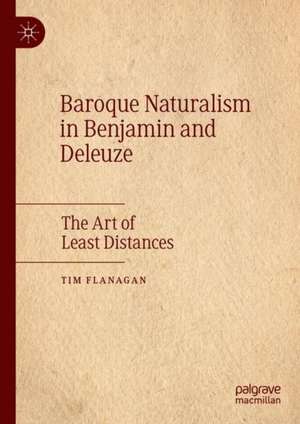Baroque Naturalism in Benjamin and Deleuze: The Art of Least Distances
Autor Tim Flanaganen Limba Engleză Hardback – 19 oct 2021
| Toate formatele și edițiile | Preț | Express |
|---|---|---|
| Paperback (1) | 696.72 lei 6-8 săpt. | |
| Springer International Publishing – 20 oct 2022 | 696.72 lei 6-8 săpt. | |
| Hardback (1) | 702.16 lei 6-8 săpt. | |
| Springer International Publishing – 19 oct 2021 | 702.16 lei 6-8 săpt. |
Preț: 702.16 lei
Preț vechi: 826.07 lei
-15% Nou
Puncte Express: 1053
Preț estimativ în valută:
134.36€ • 143.68$ • 112.03£
134.36€ • 143.68$ • 112.03£
Carte tipărită la comandă
Livrare economică 18 aprilie-02 mai
Preluare comenzi: 021 569.72.76
Specificații
ISBN-13: 9783030663971
ISBN-10: 3030663973
Pagini: 123
Ilustrații: XXIV, 288 p. 1 illus.
Dimensiuni: 148 x 210 mm
Greutate: 0.57 kg
Ediția:1st ed. 2021
Editura: Springer International Publishing
Colecția Palgrave Macmillan
Locul publicării:Cham, Switzerland
ISBN-10: 3030663973
Pagini: 123
Ilustrații: XXIV, 288 p. 1 illus.
Dimensiuni: 148 x 210 mm
Greutate: 0.57 kg
Ediția:1st ed. 2021
Editura: Springer International Publishing
Colecția Palgrave Macmillan
Locul publicării:Cham, Switzerland
Cuprins
1. Implicit Liber (a Baroque Theme).- 2. Theses on the Baroque. - 3. The Subject of the Baroque (“surpassing the logical relation between a concept and its object”).- 4. Baroque Predication: a continuous fresco, an inner concept, the propositional concept itself. - 5. “The Sublime Words of the Third Ennead”. - 6. Baroque Naturalism (A Teleological Conversion of Philosophy)
Notă biografică
Tim Flanagan is a Lecturer in Philosophy at Murdoch University, Australia. He completed his PhD in Scotland under the UK’s ‘Overseas Research Students Awards Scheme’ and works on philosophical aesthetics and the critical reception of metaphysics. He is co-editor, along with Wahida Khandker, of the series Palgrave Perspectives on Process Philosophy.
Textul de pe ultima copertă
This book, itself a study of two books on the Baroque, proposes a pair of related theses: one interpretive, the other argumentative. The first, enveloped in the second, holds that the significance of allegory Gilles Deleuze recognized in Walter Benjamin’s 1928 monograph on seventeenth century drama is itself attested in key aspects of Kantian, Leibnizian, and Platonic philosophy (to wit, in the respective forms by which thought is phrased, predicated, and proposed).The second, enveloping the first, is a literalist claim about predication itself – namely, that the aesthetics of agitation and hallucination so emblematic of the Baroque sensibility (as attested in its emblem-books) adduces an avowedly metaphysical ‘naturalism’ in which thought is replete with predicates. Oriented by Barbara Cassin’s development of the concerted sense in which homonyms are critically distinct from synonyms, the philosophical claim here is that ‘the Baroque’ names the intervallic [διαστηµατική] relation that thought establishes between things. On this account, any subject finds its unity in a concerted state of disquiet – a state-rempli in which, phenomenologically speaking, experience comprises as much seeing as reading (as St Jerome encountering Origen’s Hexapla).
Caracteristici
Provides the first critical close reading of Deleuze’s complex and understudied final monograph Situates the baroque ‘crisis of reason’ within ongoing research on religion, art, and nature in post-Kantian philosophy Underlines the links between key Platonic, Leibnizian, Kantian influences that inform contemporary theory in terms of metaphysics, philosophical aesthetics, and process thought
